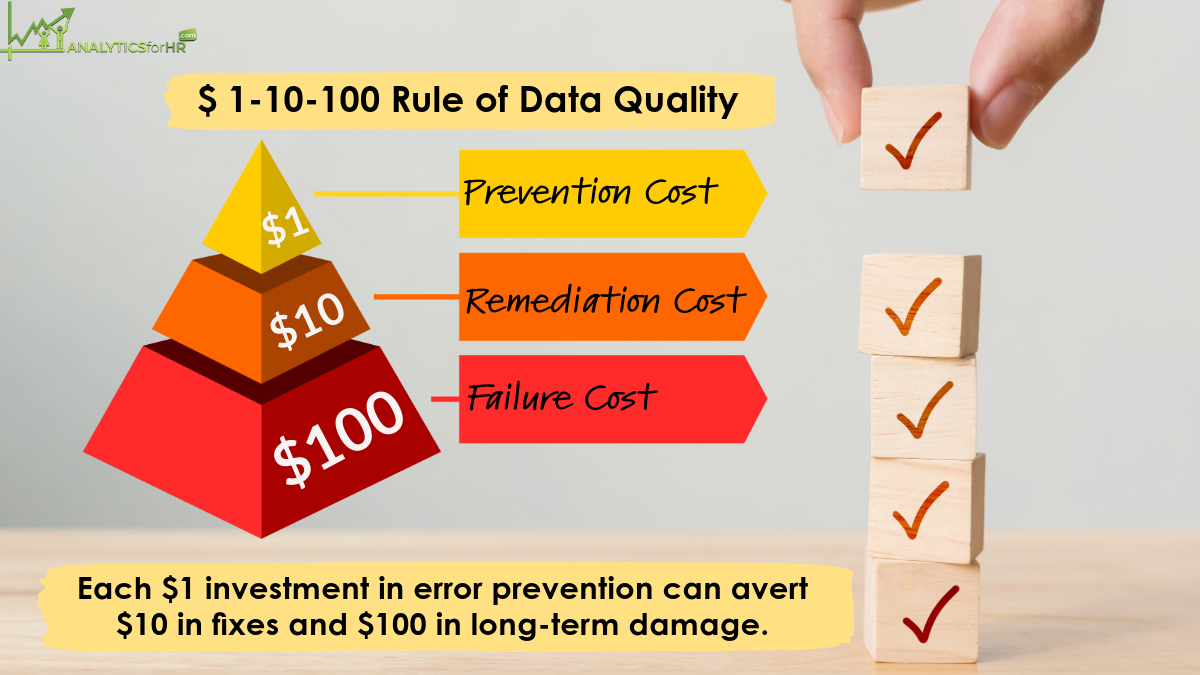The 1:10:100 Data Quality Principle in HR: How to Prevent Catastrophic Costs of HR Data Errors
Developed by George Labovitz and Yu Sang Chang in 1992, the $1, $10, $100 rule illustrates how the cost of a data error increases dramatically if it isn’t caught early.
Let’s understand 1:10:100 Data Quality rule:
Investing every $1 in error prevention today can save $10 in remediation costs and $100 in failure costs, underscoring the critical importance of proactive data quality management.
With intensified regulations in some regions and countries, the potential damages and expenses have grown substantially indicating that the rule’s impact has deepened in line with stricter global standards.
How to Apply the 1:10:100 Rule in Your Organization
Invest in Prevention ($1):
Standardize Data Entry: Create clear guidelines for how data should entered, maintained, and quality checked using 4 eye principles.
Automate Validations: Use tools like Ataccama or Informatica Data Quality to catch errors in real-time.
Train Your Team: Ensure everyone understands the importance of data accuracy and how to achieve it.
Streamline Remediation ($10):
Centralize Data: Use Enterprise Data Management (EDM) tools like Informatica MDM or SAP Master Data Governance to create a “single source of truth.”
Monitor Data Quality: Regularly check key metrics like accuracy, completeness, and consistency to catch errors early.
Establish Clear Processes: Define how errors should be reported, corrected, and prevented in the future.
Avoid the cost of Big Failure ($100):
Implement Strong Data Governance: Use frameworks like Collibra or Oracle Enterprise Data Governance to set policies, assign ownership, and monitor compliance.
Conduct Regular Audits: Periodically review your data to ensure it meets both operational and regulatory standards.
Learn from Mistakes: Analyze past errors to identify patterns and prevent them from recurring.
Key Practices for HR Data Integrity
Track the key DQ KPIs
Implement the Data Quality tool with help DQ and Data Governance team and track the KPIs such as Accuracy Rate, Completeness Score, Consistency Rate, Timeliness Index, Error Detection & Correction Rate, Data Governance Compliance.
Rigorous Data Entry Protocols
Combine human checks for sensitive fields (e.g., birthdates, IDs) with automation tools like drop-down menus or auto-filled forms. This dual approach reduces manual errors and ensures consistent data formatting from the outset.
Centralized Database & Real-Time Syncing
Maintain a single source of truth for all employee information. Automatically update connected systems to avoid redundant or outdated data, lowering the likelihood of inconsistencies across platforms.
Continuous Audit Culture
Schedule regular reviews to catch issues early and assign responsibility to cross-functional teams (legal, IT, finance). This shared oversight fosters transparency and drives collective problem-solving.
Accountability & Training
Embed data accuracy into KPIs and onboarding processes to emphasize its importance. Ongoing training ensures staff remain aware of evolving regulations, mitigating the risk of non-compliance.
Emphasis on Financial & Legal Consequences
Highlight the potential costs fines, lawsuits, and damaged reputation of poor data quality. Reinforcing these high stakes encourages continuous diligence and a long-term commitment to data governance.
Conclusion
In HR, a tiny error can lead to significant operational and legal problems. The 1:10:100 rule clearly shows that a modest investment in checking data at the point of entry is far less expensive than correcting mistakes later or dealing with their fallout. By tracking essential metrics like accuracy, completeness, timeliness, consistency, validity etc, HR professionals can catch issues early and ensure decisions are based on reliable information. In simple terms, getting your data right from the beginning is key to preventing costly errors and supporting effective, confident HR management.





